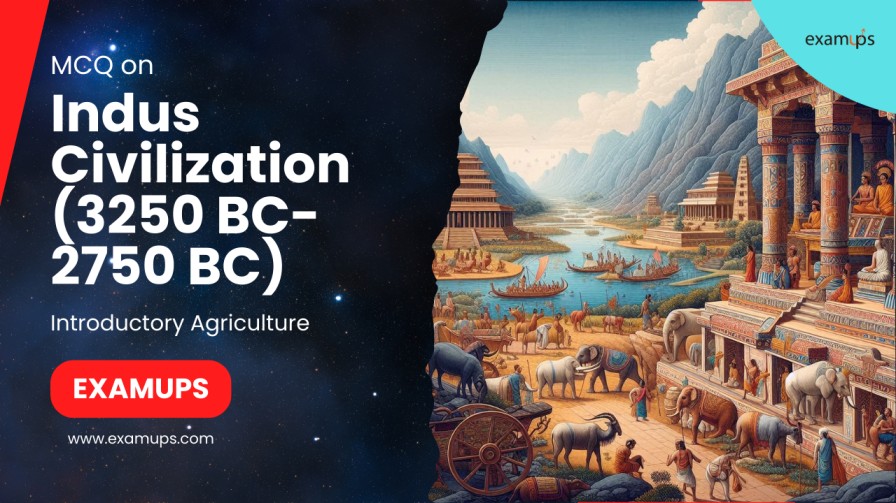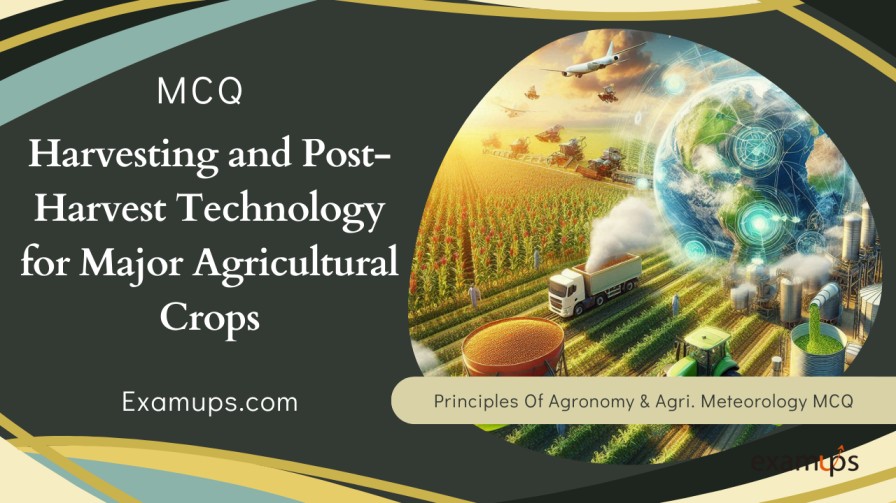MCQ On Indus Civilization (3250 BC-2750 BC) for ICAR-JEF, ICAR-SRF, ICAR-NET, IBPS-AFO/SO, Pre-PG, BHU Pre-PG, IFFCO-AGT, CCI, FCI, B.sc, M.sc, All Agriculture Competitive Exams.
1. What is another name for the Indus Valley Civilization?
a) Mohenjodara culture
b) Ravi civilization
c) Harappan culture
d) Sind civilization
**Answer: c) Harappan culture**
Explanation: The Indus Valley Civilization is also known as the Harappan culture, as mentioned in the
passage.
2. Where were the excavations conducted that led to the discovery of the Indus Valley Civilization?
a) Rajasthan
b) Gujarat
c) Punjab and Sind
d) Delhi
**Answer: c) Punjab and Sind**
Explanation: Excavations were carried out in Punjab (at Harappa) and Sind (at Mohenjodara) in
Pakistan, as mentioned in the passage.
3. What agricultural practice did the people of the Indus Valley Civilization identify as important?
a) Irrigation techniques
b) Crop rotation
c) Ploughing
d) Seed selection
**Answer: c) Ploughing**
Explanation: During the Indus Valley Civilization, people identified the importance of ploughing for
the proper sowing of crops, as stated in the passage.
4. What method of transport was commonly used during the Indus Valley Civilization?
a) Ship
b) Ox-drawn wheel cart
c) Horse-drawn carriage
d) Camel caravan
**Answer: b) Ox-drawn wheel cart**
Explanation: Ox-drawn wheel carts were commonly used for transport during the Indus Valley
Civilization, according to the passage.
5. What crops were cultivated by the people of the Indus Valley Civilization?
a) Rice and sugarcane
b) Wheat, barley, and cotton
c) Maize and potatoes
d) Millets and lentils
**Answer: b) Wheat, barley, and cotton**
Explanation: The people of the Indus Valley Civilization cultivated wheat, barley, gram, peas, sesame,
and rape, as well as cotton, as mentioned in the passage.
6. What animals were domesticated by the people of the Indus Valley Civilization?
a) Buffalo, camel, and elephant
b) Horse, cow, and dog
c) Elephant, ass, and birds
d) Buffalo, cattle, and camel
**Answer: d) Buffalo, cattle, and camel**
Explanation: The people of the Indus Valley Civilization domesticated buffalo, cattle, camel, horse,
elephant, ass, and birds, as stated in the passage.
7. What was the purpose of the Great Granary discovered in Harappa?
a) Religious ceremonies
b) Storage of food grain
c) Residence for rulers
d) Administrative center
**Answer: b) Storage of food grain**
Explanation: The Great Granary discovered in Harappa was used for storing food grain, as mentioned
in the passage.
8. How were wages paid to artisans and laborers during the Indus Valley Civilization?
a) In coins
b) In kind (food grain)
c) In gold and silver
d) In labor vouchers
**Answer: b) In kind (food grain)**
Explanation: Artisans, carpenters, and others received their wages in kind from the farmers,
according to the passage.
9. What can be inferred about the economic system of the Indus Valley Civilization based on the
description of the Great Granary?
a) It was a centrally planned economy
b) It relied heavily on barter
c) It had a sophisticated system of storage and distribution
d) It was primarily a subsistence economy
**Answer: c) It had a sophisticated system of storage and distribution**
Explanation: The description of the Great Granary suggests a sophisticated system of storage and
distribution, indicating an advanced economic system.
10. Which rivers were significant in the geographical location of the Indus Valley Civilization?
a) Ganges and Yamuna
b) Indus and Ravi
c) Tigris and Euphrates
d) Nile and Niger
**Answer: b) Indus and Ravi**
Explanation: The cities of the Indus Valley Civilization were built along the river Indus and the river
Ravi, as mentioned in the passage.
11. What is the meaning of the word “Veda”?
a) Land of seven rivers
b) Pastoralism
c) Knowledge
d) Rig-veda
**Answer: c) Knowledge**
Explanation: The word “Veda” is derived from “Vid,” which means “Knowledge.”
12. Which book is considered the oldest among the Aryans?
a) Rig-veda
b) Mahabharata
c) Ramayana
d) Atharvaveda
**Answer: a) Rig-veda**
Explanation: The Rig-veda is considered the oldest book among the Aryans.
13. What was the main occupation of the Vedic Aryans?
a) Agriculture
b) Trading
c) Pastoralism
d) Hunting
**Answer: c) Pastoralism**
Explanation: The Vedic Aryans were primarily pastoral.
14. Which rivers were included in the “land of seven rivers”?
a) Ganges, Brahmaputra, Yamuna
b) Ganga, Godavari, Kaveri
c) Satlaj, Beas, Ravi, Chennab, Jhelum, Indus, Saraswathi
d) Narmada, Tapti, Mahanadi
**Answer: c) Satlaj, Beas, Ravi, Chennab, Jhelum, Indus, Saraswathi**
Explanation: The land of seven rivers included Satlaj, Beas, Ravi, Chennab, Jhelum, Indus, and
Saraswathi.
15. What were the main crops cultivated during the later Vedic period?
a) Rice and cotton
b) Barley, sesame, and sugarcane
c) Wheat and lentils
d) Millet and sorghum
**Answer: b) Barley, sesame, and sugarcane**
Explanation: During the later Vedic period, the main crops cultivated were barley, sesame, and
sugarcane.
16. Which agricultural implement is mentioned in Vedic literature?
a) Tractor
b) Plough
c) Harvester
d) Seeder
**Answer: b) Plough**
Explanation: The plough (langala) is mentioned as an agricultural implement in Vedic literature.
17. What ritual marked the beginning of the ploughing season in Vedic agriculture?
a) Offering sacrifices
b) Planting trees
c) Inaugurating the first ploughing with rituals
d) Praying to rain gods
**Answer: c) Inaugurating the first ploughing with rituals**
Explanation: In Vedic agriculture, the first ploughing of the season was inaugurated amidst much
ritual.
18. What was used for irrigation in Vedic agriculture?
a) Canals from rivers
b) Sprinklers
c) Modern irrigation pumps
d) Rainwater harvesting
**Answer: a) Canals from rivers**
Explanation: Channels were dug from rivers for irrigation in Vedic agriculture.
19. What were kucha wells used for?
a) Washing clothes
b) Drinking water and irrigation
c) Bathing
d) Cooking
**Answer: b) Drinking water and irrigation**
Explanation: Kucha wells were used for drinking water and irrigation in Vedic agriculture.
20. Which crops were not mentioned in the early Vedic period but cultivated during the Harappa
period?
a) Wheat and barley
b) Rice and cotton
c) Millet and sorghum
d) Sugarcane and sesame
**Answer: b) Rice and cotton**
Explanation: Rice and cotton were cultivated during the Harappa period but not mentioned in the
early Vedic period.
21. What was the primary literary source of knowledge about the Aryans in India?
a) Mahabharata
b) Ramayana
c) Vedas
d) Arthashastra
**Answer: c) Vedas**
Explanation: The Vedas, derived from the word “Vid” meaning “Knowledge,” are the primary literary
source from which we know about the Aryans in India, as mentioned in the passage.
22. Which rivers comprised the land of the Aryans, according to Vedic literature?
a) Ganges, Yamuna, Brahmaputra
b) Indus, Ganges, Saraswati
c) Ganges, Brahmaputra, Godavari
d) Tigris, Euphrates, Nile
**Answer: b) Indus, Ganges, Saraswati**
Explanation: According to Vedic literature, the land of the Aryans was comprised of seven rivers,
including the Indus, Ganges, and Saraswati, as mentioned in the passage.
23. What was the primary occupation of the Vedic Aryans?
a) Agriculture
b) Trading
c) Pastoralism
d) Fishing
**Answer: c) Pastoralism**
Explanation: The Vedic Aryans were primarily pastoral, as stated in the passage. They were involved
in grazing animals and cultivating crops near their settlements.
24. What irrigation methods were used by the Vedic people?
a) Canals from rivers and kucha wells
b) Dams and reservoirs
c) Rainwater harvesting
d) Sprinkler irrigation
**Answer: a) Canals from rivers and kucha wells**
Explanation: The Vedic people used canals from rivers and kucha wells (simple holes dug in the
ground) for irrigation, as mentioned in the passage.
25. Which crops were cultivated during the Vedic period?
a) Rice and cotton
b) Wheat and barley
c) Corn and potatoes
d) Sorghum and millet
**Answer: b) Wheat and barley**
Explanation: In the Vedic period, crops such as wheat and barley were cultivated, as mentioned in
the passage.
26. What was Lemuria believed to be according to ancient legends?
a) A sunken continent connecting India and Australia
b) A vast desert region in Africa
c) An ancient city in Mesopotamia
d) A mythical land of giants
**Answer: a) A sunken continent connecting India and Australia**
Explanation: According to ancient legends, Lemuria was believed to be a vast sunken continent or
land bridge connecting India and Australia, as described in the passage.
27. What is the significance of the name “Lemuria”?
a) It refers to a land of giants
b) It means “Land of the Ancestors”
c) It represents a mythical paradise
d) It signifies a barren desert
**Answer: b) It means “Land of the Ancestors”**
Explanation: The name “Lemuria” is significant as it means “Land of the Ancestors” or “Land
Ancestral,” as mentioned in the passage.
28. What evidence supports the existence of Lemuria according to Tamil bark writings?
a) Ancient manuscripts describing its location
b) Fossil records of prehistoric animals
c) Oral traditions passed down through generations
d) Geological formations and sunken landmasses
**Answer: c) Oral traditions passed down through generations**
Explanation: According to Tamil bark writings, evidence for the existence of Lemuria comes from oral
traditions passed down through generations, as mentioned in the passage.
29. When was Lemuria believed to have sunk?
a) During the Ramayana period
b) During the Mahabharata period
c) During the Indus Valley Civilization
d) During the Harappan Civilization
**Answer: a) During the Ramayana period**
Explanation: Lemuria was believed to have sunk before the Ramayana period, as stated in the
passage.
30. What was the significance of Lemuria for India and Australia?
a) It served as a trade route between the two regions
b) It connected the two regions geographically
c) It was a cultural center for both regions
d) It influenced the mythology and folklore of both regions
**Answer: d) It influenced the mythology and folklore of both regions**
Explanation: Lemuria’s existence influenced the mythology and folklore of both India and Australia,
as described in the passage.









